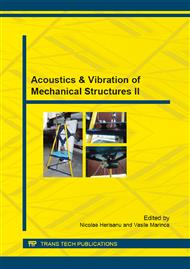p.148
p.154
p.159
p.165
p.171
p.176
p.182
p.188
p.197
Dynamic Analysis of a Base Isolated Building Having Zener Rheological Connections at Seismic Unidirectional Translations
Abstract:
The paper presents the physical model and the experimental results of a building having its base isolated with elastomeric and dissipative devices arranged in a functional configuration equivalent to that of the Zener rheological model.The harmonic motion of excitation at dominant frequency, which corresponds to a narrow band portion of the seismic composition spectrum, generates an inertial excitation force for the building modeled as a rigid-body with unidirectional displacement. Thus, the parameters of the unidirectional translation motion function of the inertial and of the linear viscoelastic characteristics of the Zener rheological model are analyzed.In essence, the amplitude of the displacement of the mass function of the fundamental spectral amplitude of the ground during an earthquake and the transmissibility or the isolation degree of the Zener rheological system are determined.
Info:
Periodical:
Pages:
171-175
Citation:
Online since:
October 2015
Authors:
Keywords:
Price:
Сopyright:
© 2015 Trans Tech Publications Ltd. All Rights Reserved
Share:
Citation:


